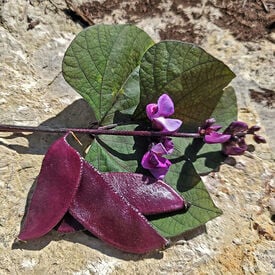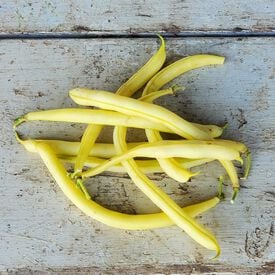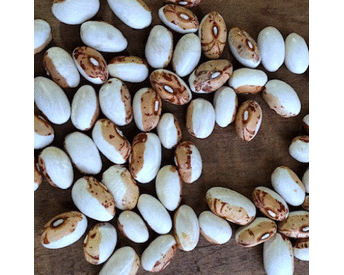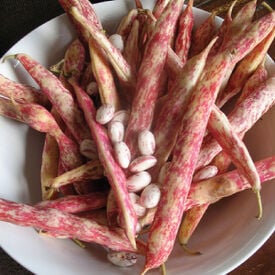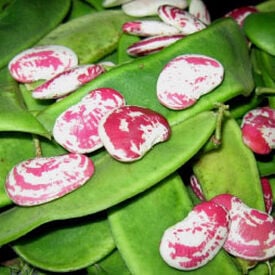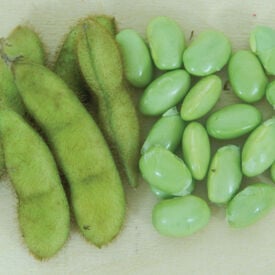Learn More
Calypso bean seeds, also known as "Yin Yang" beans for their striking black-and-white pattern, produce compact bush plants that typically grow 15 to 20 inches tall. These heirloom beans mature in about 70 to 90 days and are cherished for their creamy texture and mild, earthy flavor, making them ideal for soups, stews, and salads. Calypso beans are easy to grow, thriving in full sun and well-drained soil, and they offer good drought tolerance. Their unique appearance and reliable performance make them a favorite among gardeners and heirloom seed enthusiasts alike.
Ruby Moon Hyacinth Bean, also known as Lablab purpureus or simply Hyacinth Bean, is a unique and versatile legume known for its vibrant appearance and culinary potential. This heirloom variety is named for its striking ruby-red pods and dark green foliage, making it an attractive addition to both ornamental and edible gardens. Ruby Moon Hyacinth Beans are typically grown as annuals, but in tropical regions, they can be perennial. In terms of taste, the young pods and seeds of Ruby Moon Hyacinth Bean are edible and have a mild, nutty flavor similar to green beans. They can be consumed both raw and cooked. However, it's important to note that mature seeds contain toxic compounds and should not be eaten without proper processing. Ruby Moon Hyacinth Beans have a rich history, with their cultivation dating back centuries, primarily in Asia and Africa. They are valued not only for their culinary uses but also for their ability to fix nitrogen in the soil, enhancing soil fertility. This plant is categorized as a warm-season annual and typically matures in about 60-90 days, depending on growing conditions. The size of the Ruby Moon Hyacinth Bean plant can vary, but it generally reaches a height of 6-10 feet, making it suitable for trellises or fences. When it comes to yield, you can expect approximately 10-15 pounds of pods per plant or around 800-1,200 pounds per acre under ideal conditions. These beans thrive in full sun and well-drained soil, and they require a warm climate to grow successfully. Adequate moisture and support for climbing are essential for a bountiful harvest. With proper care, Ruby Moon Hyacinth Beans can be a delightful addition to your garden, offering both visual appeal and a tasty, nutritious addition to your plate.
Flora de Junio bean seeds produce vibrant heirloom pole beans traditionally grown in Mexico, known for their striking maroon and white speckled pods and seeds. These vigorous climbing plants can reach a height of 6 to 8 feet, making them ideal for trellises or poles. They mature in approximately 90 to 100 days and are prized for their dual-purpose use as both fresh snap beans when young and dry beans when fully mature. Flora de Junio beans are celebrated for their rich, earthy flavor and resilience, thriving in warm climates with well-drained soil.
Kenearly Yellow Eye bean seeds produce bush-type plants that grow to about 18 to 24 inches tall and are known for their high yields and disease resistance. These heirloom beans mature in approximately 85 to 95 days and are distinguished by their creamy white seeds with a distinct yellow "eye" marking. Valued for their mild, buttery flavor and smooth texture, Kenearly Yellow Eye beans are excellent for soups, stews, and baked dishes. They thrive in well-drained soil and full sun, and their compact growth habit makes them easy to harvest and ideal for small garden spaces.
Dapple Grey bean seeds grow into compact bush plants reaching about 18 to 24 inches in height and typically mature in 85 to 95 days. This heirloom dry bean variety is known for its eye-catching gray seeds mottled with darker streaks, giving it a distinctive “dappled” appearance. Dapple Grey beans have a rich, hearty flavor and a firm texture, making them a popular choice for soups, stews, and chili. Easy to grow and well-adapted to a variety of climates, these beans thrive in full sun and well-drained soil, offering reliable yields and excellent storage quality.
Fava Broad Windsor beans, also known as Vicia faba 'Broad Windsor,' are a classic heirloom variety with a storied history and a range of notable characteristics. Originating in the United Kingdom, this variety has been cultivated for centuries and is particularly valued for its large, hearty beans and reliable yield. The plants are characterized by their robust growth habit, reaching heights of 24 to 36 inches, with broad, dark green leaves and striking white flowers often tinged with purple. The beans themselves are large and plump, typically encased in thick, protective pods that turn from green to a rich brown as they mature. Fava Broad Windsor beans are known for their creamy, slightly nutty flavor, which becomes more pronounced when the beans are cooked. The plants generally bloom in late spring to early summer, and the beans are usually harvested about 80 to 90 days after sowing. They thrive in cool, well-drained soil and prefer full sun to partial shade. The robust nature of the plants and their ability to fix nitrogen in the soil make them a valuable crop for improving soil fertility in rotation systems. With their rich flavor, historical significance, and agronomic benefits, Fava Broad Windsor beans are a cherished choice for both traditional and modern gardens.
Beautiful bright yellow beans that grow on 5-6" pods. They grow straight and on large, upright plants. A flavorful bean with high disease resistance.
The Hidatsa Shield bean, an heirloom variety with deep cultural roots, traces its origins to the Hidatsa people of the northern Great Plains in the United States. This ancient cultivar was cherished for its hardiness and flavor, embodying a vital part of the Hidatsa diet for centuries. The bean is named for its distinctive shield-shaped markings, which can range from mottled browns and reds to purples, giving it a striking appearance. Its flavor profile is noted for a rich, nutty taste with a creamy texture, making it a favored choice in various traditional dishes. The plant itself is a vigorous climber, known for its adaptability to different soil types and growing conditions. It typically blooms in mid-summer, producing small, pale flowers before setting pods that are ready for harvest in late summer or early fall. The Hidatsa Shield bean's resilience and ease of cultivation, coupled with its historical significance, continue to make it a valued crop among gardeners and food enthusiasts.
Jacob’s Cattle Gold bean seeds produce robust bush plants that grow to about 18 to 24 inches tall and mature in approximately 85 to 95 days. A golden-hued variant of the traditional Jacob’s Cattle bean, this heirloom variety features beautiful tan seeds with maroon speckles and splashes. Renowned for their creamy texture and rich, slightly sweet flavor, Jacob’s Cattle Gold beans are ideal for baking, soups, and slow-cooked dishes. They perform well in a range of garden soils, thrive in full sun, and offer consistent yields, making them a favorite among home gardeners and heirloom collectors.
Whiskey Mountain bean seeds produce a rare and distinctive heirloom pole bean known for its vigorous growth, striking appearance, and excellent flavor. The plants climb tall and robustly, requiring support, and yield long, tender pods that can be enjoyed as fresh snap beans or allowed to mature into colorful dry beans. The dry beans often feature unique markings and a rich, earthy taste that makes them ideal for soups and stews. Named after the scenic Whiskey Mountain region, this variety is valued for both its resilience in diverse growing conditions and its ornamental appeal in the garden. With its combination of beauty, hardiness, and culinary versatility, Whiskey Mountain is a treasured choice for gardeners seeking something special.
The Vermont Cranberry Shell bean is an incredible bean variety that can be used as a snap, shell or dry bean. Cranberry Shell stores exceptionally well. Maroon colored beans are decorated with darker red, cranberry markings. This variety dates back to the 1800s and is well-suited to short-season, cool summer climates.
Pink Half Runner bean seeds produce a traditional Appalachian favorite known for its tender pods and flavorful pink-mottled seeds. These beans grow as semi-vining plants—hence the term "half runner"—which means they can be grown with or without support, though a short trellis or fence can improve yields and ease of harvest. The pods are medium-length, stringy when mature, and typically harvested young for snap beans or allowed to mature for shelling or dry use. Pink Half Runners are celebrated for their rich, old-fashioned flavor, making them ideal for slow-cooked dishes and canning. Adaptable and prolific, they perform well in a range of growing conditions and continue to be a cherished staple in many Southern gardens.
Soldier bean seeds produce a traditional New England heirloom dry bean known for its creamy white color and distinctive reddish-brown marking near the hilum that resembles a toy soldier—hence the name. These bush-type plants are hardy and compact, typically reaching maturity in about 85 to 95 days, and they yield reliably even in cooler climates. Soldier beans are especially prized for their mild, earthy flavor and smooth texture, making them a favorite for baked beans, soups, and stews. Their excellent storage qualities and historical significance have kept them a staple in regional cooking for generations. Easy to grow and harvest, Soldier beans are a dependable and flavorful addition to any garden.
Christmas bean, scientifically known as Phaseolus vulgaris 'Christmas,' is a delightful and unique variety of green bean that adds a festive touch to holiday meals. This particular bean cultivar has a fascinating history dating back to the early 20th century when it was first developed by dedicated plant breeders. Its name, "Christmas bean," is derived from its vibrant red and green coloration, reminiscent of traditional holiday colors. In terms of taste, Christmas beans are known for their tender and crisp texture, making them a delightful addition to a variety of dishes. Their flavor is mildly sweet with a subtle nuttiness, making them a versatile choice for both cooking and salads. The beans typically mature in about 80 to 90 days, making them a relatively quick-growing option for gardeners. The pod size is medium to large, with an average length of 6-7 inches, perfect for harvesting when they are young and tender. Christmas bean plants need staked and can grow up 10' and higher! They are known for their disease resistance, particularly against common bean diseases such as rust and bean mosaic virus. When properly cared for, Christmas bean plants can yield an abundant harvest, with each plant producing a substantial number of pods. For optimal growth, they require well-drained soil, full sun exposure, and regular watering. Plant spacing should be about 4-6 inches apart in rows, and they thrive in a variety of climates, making them a popular choice for gardeners looking to add a festive touch to their holiday season while enjoying a bountiful harvest of delicious, colorful beans.
Amarillo beans (Frijol Amarillo) are a beloved heirloom variety in Mexican cuisine, known for their golden-yellow color and slightly sweet, earthy flavor. These beans are medium-sized, with a smooth texture that makes them perfect for use in a variety of traditional dishes, such as stews, soups, and frijoles de la olla. Their subtle flavor and creamy consistency when cooked make them a versatile ingredient in both savory and vegetarian meals. Grown primarily in the central and southern regions of Mexico, Amarillo beans are well-suited to a range of climates and soil types, offering resilience and a reliable yield. As an open-pollinated variety, they are ideal for sustainable farming practices and seed-saving, ensuring that this flavorful and nutritious bean continues to play an essential role in both Mexican agriculture and cuisine.
Cinnabar Mountain bean seeds produce striking, ornamental pole beans known for their vivid scarlet flowers and long, slender pods. This variety is not only visually appealing but also productive, climbing vigorously and yielding beans that can be eaten young as snap beans or left to mature for dry beans. Named after the cinnabar-red hues of its blooms, it attracts pollinators like hummingbirds and bees, making it a beautiful and beneficial addition to gardens. The plants thrive in warm weather with full sun and well-drained soil, and they require sturdy trellising due to their vigorous vining habit. Cinnabar Mountain beans combine aesthetic charm with culinary value, making them a favorite for both ornamental and edible landscapes.
Quicksilver Mountain bean seeds grow into a vigorous pole bean variety prized for its elegant, silver-speckled dry beans and reliable performance in the garden. The tall, climbing vines produce long, slender green pods that can be harvested young as tender snap beans or left to mature into striking dry beans with a smooth, pale base marked by silvery patterns. Known for their creamy texture and rich, nutty flavor when cooked, Quicksilver Mountain beans are ideal for hearty dishes like soups, stews, and casseroles. This variety thrives in full sun with support from a trellis or pole structure and is favored by gardeners for both its visual appeal and culinary quality.
Envy is an early harvesting edamame for shorter growing seasons. Envy produces erect bush bean plants that reach about two feet in height and produce pods each containing two to three green seeds. Edamame is a popular snack in Japan, served with beer. Due to its health benefits that other snacks do not provide, it is becoming popular in the United States.

